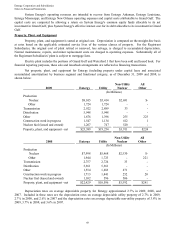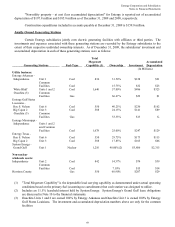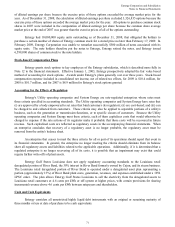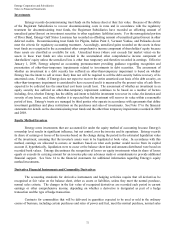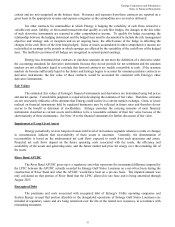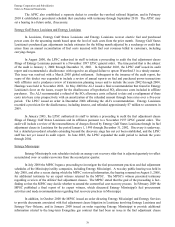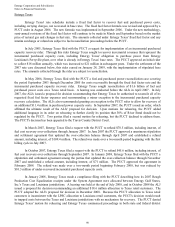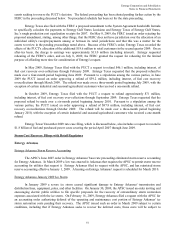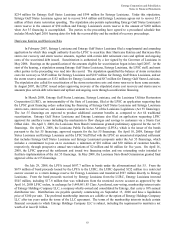Entergy 2009 Annual Report Download - page 76
Download and view the complete annual report
Please find page 76 of the 2009 Entergy annual report below. You can navigate through the pages in the report by either clicking on the pages listed below, or by using the keyword search tool below to find specific information within the annual report.
Entergy Corporation and Subsidiaries
Notes to Financial Statements
72
Taxes Imposed on Revenue-Producing Transactions
Governmental authorities assess taxes that are both imposed on and concurrent with a specific revenue-
producing transaction between a seller and a customer, including, but not limited to, sales, use, value added, and
some excise taxes. Entergy presents these taxes on a net basis, excluding them from revenues, unless required to
report them differently by a regulatory authority.
Presentation of Non-Controlling Interests
In 2007, a new accounting pronouncement was issued regarding non-controlling interests that requires
generally that ownership interests in subsidiaries held by parties other than the reporting company (non-controlling
interests) be clearly identified, labeled, and presented in the consolidated balance sheet within equity, but separate
from the controlling shareholders' equity, and that the amount of consolidated net income attributable to the reporting
company and to the non-controlling interests be clearly identified and presented on the face of the consolidated
income statement. This new accounting pronouncement became effective for Entergy in the first quarter 2009 and
applies to preferred securities issued by Entergy subsidiaries to third parties.
Presentation of Preferred Stock without Sinking Fund
In connection with the adoption of the new accounting pronouncement regarding non-controlling interests
Entergy evaluated the accounting standards regarding the classification and measurement of redeemable securities.
These standards require the classification of securities between liabilities and shareholders' equity on the balance
sheet if the holders of those securities have protective rights that allow them to gain control of the board of directors
in certain circumstances. These rights would have the effect of giving the holders the ability to potentially redeem
their securities, even if the likelihood of occurrence of these circumstances is considered remote. The Entergy
Arkansas, Entergy Mississippi, and Entergy New Orleans articles of incorporation provide, generally, that the
holders of each company's preferred securities may elect a majority of the respective company's board of directors if
dividends are not paid for a year, until such time as the dividends in arrears are paid. Therefore, Entergy Arkansas,
Entergy Mississippi, and Entergy New Orleans present their preferred securities outstanding between liabilities and
shareholders' equity on the balance sheet. Entergy Gulf States Louisiana and Entergy Louisiana, both organized as
limited liability companies, have outstanding preferred securities with similar protective rights with respect to unpaid
dividends, but provide for the election of board members that would not constitute a majority of the board; and their
preferred securities are therefore classified for all periods presented as a component of members' equity.
The outstanding preferred securities of Entergy Arkansas, Entergy Mississippi, Entergy New Orleans, and
Entergy Asset Management, whose preferred holders also have protective rights as described in Note 6 to the
financial statements, are similarly presented between liabilities and shareholders' equity on Entergy's consolidated
balance sheets and the outstanding preferred securities of Entergy Gulf States Louisiana and Entergy Louisiana are
presented within total equity in Entergy's consolidated balance sheets. The preferred dividends or distributions paid
by all subsidiaries are reflected for all periods presented outside of consolidated net income.
Subsequent Events
Entergy evaluated events of which its management was aware subsequent to December 31, 2009, through the
date that this annual report was issued.
New Accounting Pronouncements
In June 2009 the FASB issued SFAS 167, "Amendments to FASB Interpretation No. 46R". SFAS 167
replaces the current quantitative-based risks and rewards calculation for determining which enterprise, if any, has a
controlling financial interest in a variable interest entity with an approach focused on identifying which enterprise has
the power to direct the activities of a variable interest entity that most significantly affect the entity's economic
performance and (1) the obligation to absorb losses of the entity or (2) the right to receive benefits from the entity.
74






